6 min read
The effect of the housing environment and handling on behavior assays
By: MD Biosciences on Sep 19, 2022 9:29:11 PM
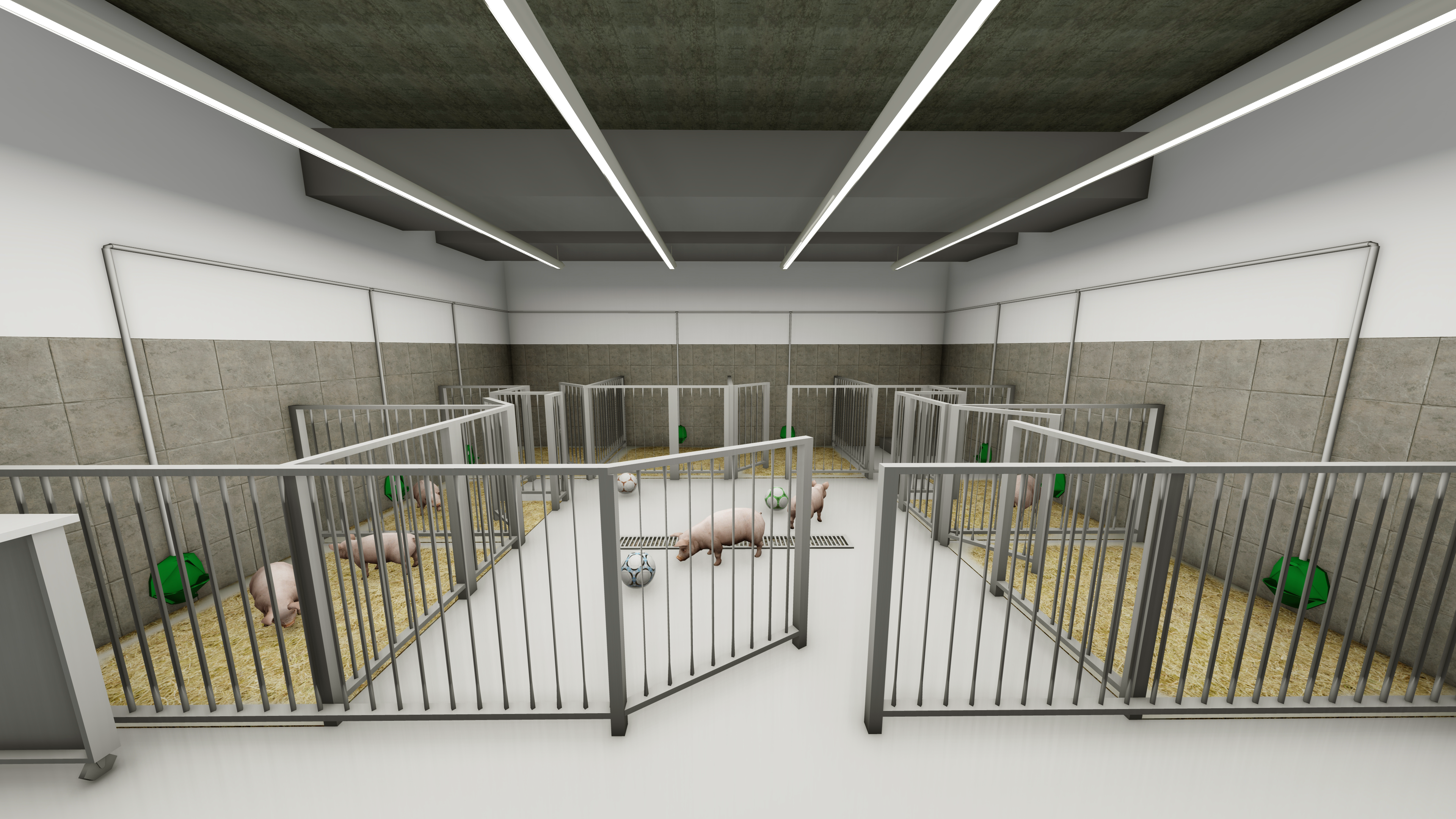
An excerpt from MD Biosciences publication in the Autumn 2022 issue of Göttingen Minipigs Magazine.
MD Biosciences operates a neuroscience research facility that was purpose-built for translational research and includes dedicated wings for in vitro and biomarker assays, rodent and translational pig research. Since the opening of the research facility in 2021, we have been monitored the effect of this purpose-built facility on behavior assays and compared it to data from standard housing facilities. Findings are ongoing, however an intermediate finding of results has been published.
Across species, it is an established fact that behavior assays depend on housing environmental conditions such as light/dark cycles, temperature and humidity, noise, bedding, enrichment, and handling. In farm pigs, poor housing in barren conditions can cause damaging behaviors such as tail and ear biting. These factors lead to chronic stress and alteration of the pig’s immunity, and can affect pain behavior significantly.
Pain by definition, is a subjective experience. This makes pain evaluation in humans challenging and almost impossible to do by another person. In humans, the assessment of pain mostly relies on verbal reporting, while in animals, the assessment of pain relies on animal withdrawal from a stimulus and/or behavioral scoring. Both approaches are highly dependent, among other things, on the animal’s stressful or stress-free environment.
In this report, we examine the effect of Standard Housing Conditions (SHC) and Specifically Designed Housing Conditions (SDHC) focused on behavioral assessment on the pig outcome following PNT induction of chronic pain.
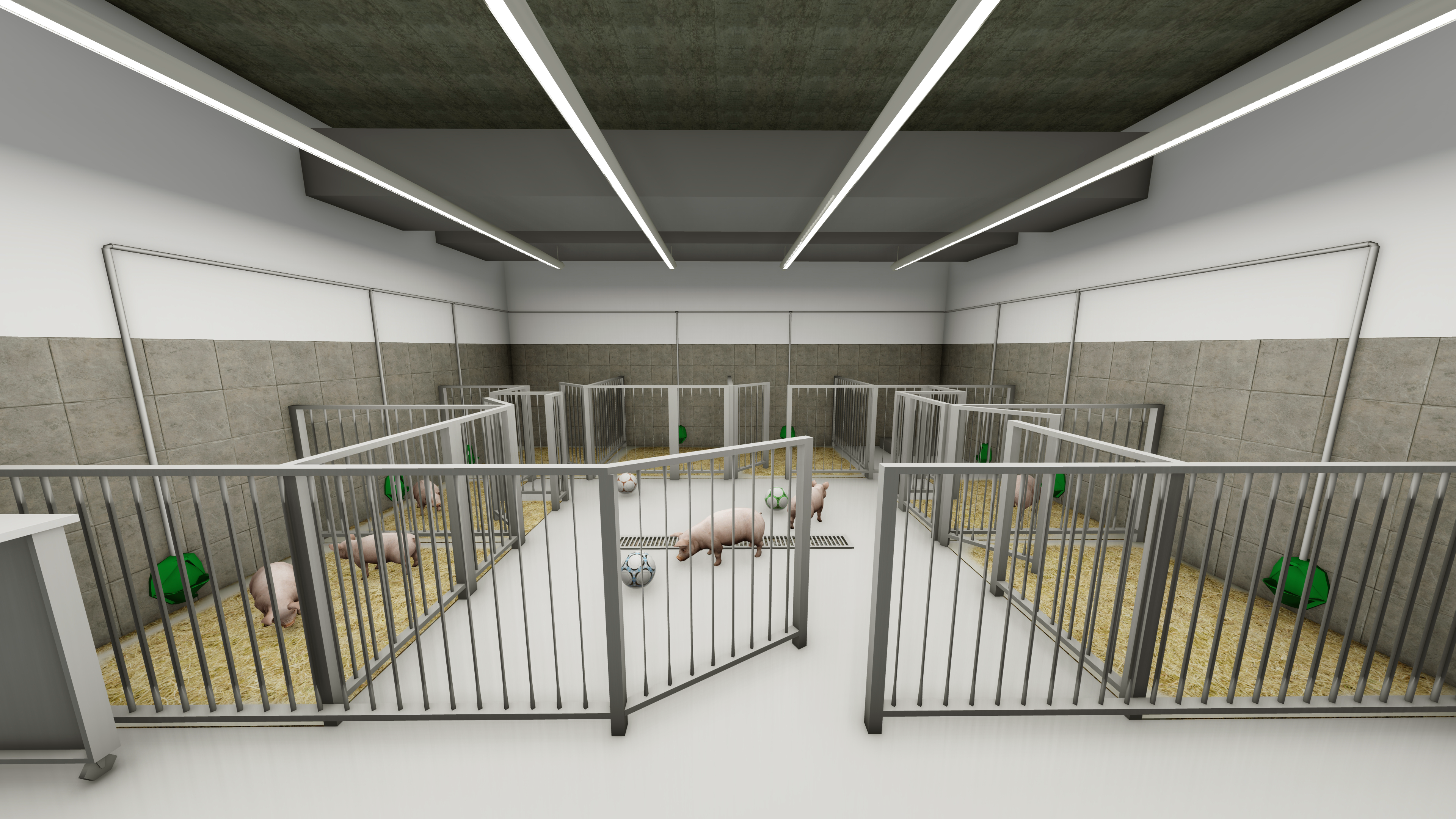
The model was running in two different vivariums: one is a standard swine facility for research, and the other is a new, state-of-the-art facility, specifically purpose-built for swine behavior studies.
The standard facility houses pigs in a corridor of rectangular pens on both sides, which are separated by opaque walls. Pigs are housed in groups of two or three, and the animals and pens are washed each morning with water. The animals are fed twice daily, and enrichments includes a choice of materials and balls. A well-trained caretaker enters the pens once daily for handling. While all tests are carried out in the pig ́s home pen, locomotor activity is evaluated by gently walking the pigs to the open field arena, (sized 1.2mX2.4m). Supportive medications such as antibiotics are delivered by IM injections.
The new facility is built in a U-shape with square pens separated by bars allowing the pigs to interact with one another visually and vocally. The open side of the U-shape has a gate leading to a shared, middle space in which the pigs can enter and play. Pigs may interact freely with pigs from other pens. The pigs are held on sawdust that is replaced daily with no washing and are fed twice daily. Pens are opened twice daily for the animals to play with the caretaker (rope, balls, “feed-me”, and other tasks). All medication is administered orally after training.
Pigs are also taught to climb on to the balance weighing scale. This paper reports the preliminary results of an on-going study that looks at the effect of the different housing and handling conditions on the outcome of a PNT model.
Behavior tests evaluated in both SDH and SDHC:
Approaching test to assess acclimationThe normal behavior of the pigs upon the entry of the researcher entering their housing pen is to initially move away from the intruder and then approach them. The more familiar the pigs are with the person and the more comfortable they feel, the less time it takes them to approach.
Data below shows the time in seconds that it took for the animals to approach the researcher entering their pen. Animals housed in the SDHC facility acclimated faster as was expressed by the faster reduction in the approaching time on study day 4 and 10 (***p<0.001 vs. SDHC).
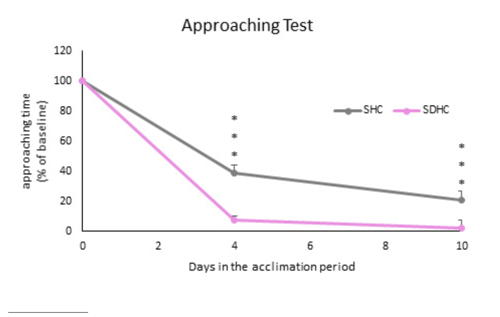
Von Frey Testing to assess allodynia
The withdrawal response to mechanical stimulation was as- sessed using the von Frey methodology. The animals housed in the SDHC facility showed more stable results and also expressed higher withdrawal force vs. the animals housed in the SHC facility (*p<0.05 vs. SDHC).
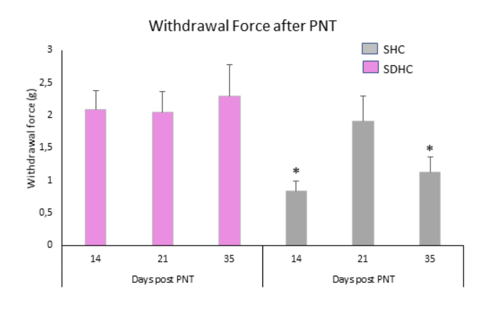
The open field apparatus size was either 2.5m wide by 4.8 meters long (smaller open field), or 4 meters wide by 4 meters long (new open field). The walls of the small open-field were smooth and 1.6m high. The new open field was a separate room. The animals were introduced to the open field for 5 minutes. The walking pattern of the animals was recorded using a CCTV camera connected to the AnyMaze data acquisition software. After each open field session, the total walking distance was presented, as well as the walking pattern.
At baseline, before the injury, the animals that were exposed to the larger open-field arena in the SDHC facility walked significantly more than the animals exposed to the smaller open- field arena in the SHC facility (figure 4) (56.33±21.13 meters vs. 73.57±35.72).
Following PNT the animals exposed to the smaller open field arena, at the SHC facility, showed a transient decrease in loco- motor activity. Animals exposed to the large open field arena showed no change in the locomotor activity and no reduction in walking distance.
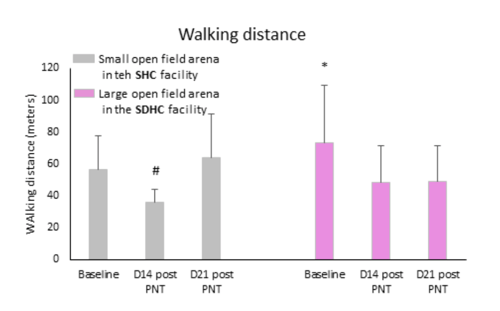
Summary
The results of this study are ongoing, however some notable differences have already been observed between SHC and SDHC and the effect on behavior assays:
- The acclimation period is very critical in behavior studies. The normal behavior of pigs is to move away from a person entering their pen, followed by their approach to the investigator. The latency time for the pigs to approach the intruder reflects their calm or distressed behavior. In this study, we show that the habituation of the pigs to a repeat intruder in their home pen was more rapid in the SDHC facility than in the SHC facility. The pigs were calmer and far less stressed, which shows that the SDHC facility potentially offers a better solution for behavior assays in pigs.
- The SDHC facility provides pigs more opportunities for physical activity during their housing period. They walk more, can freely access the shared space, and are intrigued by different tasks. Animals in the SDHC facility had higher sensitivity to Von Frey compared to the animals housed in the SHC facility. The relatively higher withdrawal force obtained in animals housed in the SDHC facility is possibly due to increased animal mobility fact that the animals were able to move more. In humans, it is shown that moderate regular exercise decreases excitability and improves inhibition in both the central nervous system (brainstem inhibitory/facilitatory sites) and the immune system.
- The animals were introduced to a small open field (SHC) or a large open field (SDHC). The animals that were introduced to the large open field (SDHC facility) walked more before the PNT operation. An interesting difference was found in the walking pattern after PNT operation between the animals housed in the SHC facility and those housed in SDHC facility. The animals housed in the SHC facility tended to walk in circles, avoiding the central zone. This behavior suggests distress, and is in line with what we have previously reported in young castrated domestic pigs.
To read the full publication, click here.
For a virtual walk through of the CNS Research Facility with Specifically designed housing conditions (SDHC), click here.
To speak with a neuroscientist about running a translational pig model, click here.
Related Posts
Pain Response in Pigs Mimics Human Pain Behavior
The pig peripheral neuritis trauma (PNT) model is an important transitional model that bridges the...


